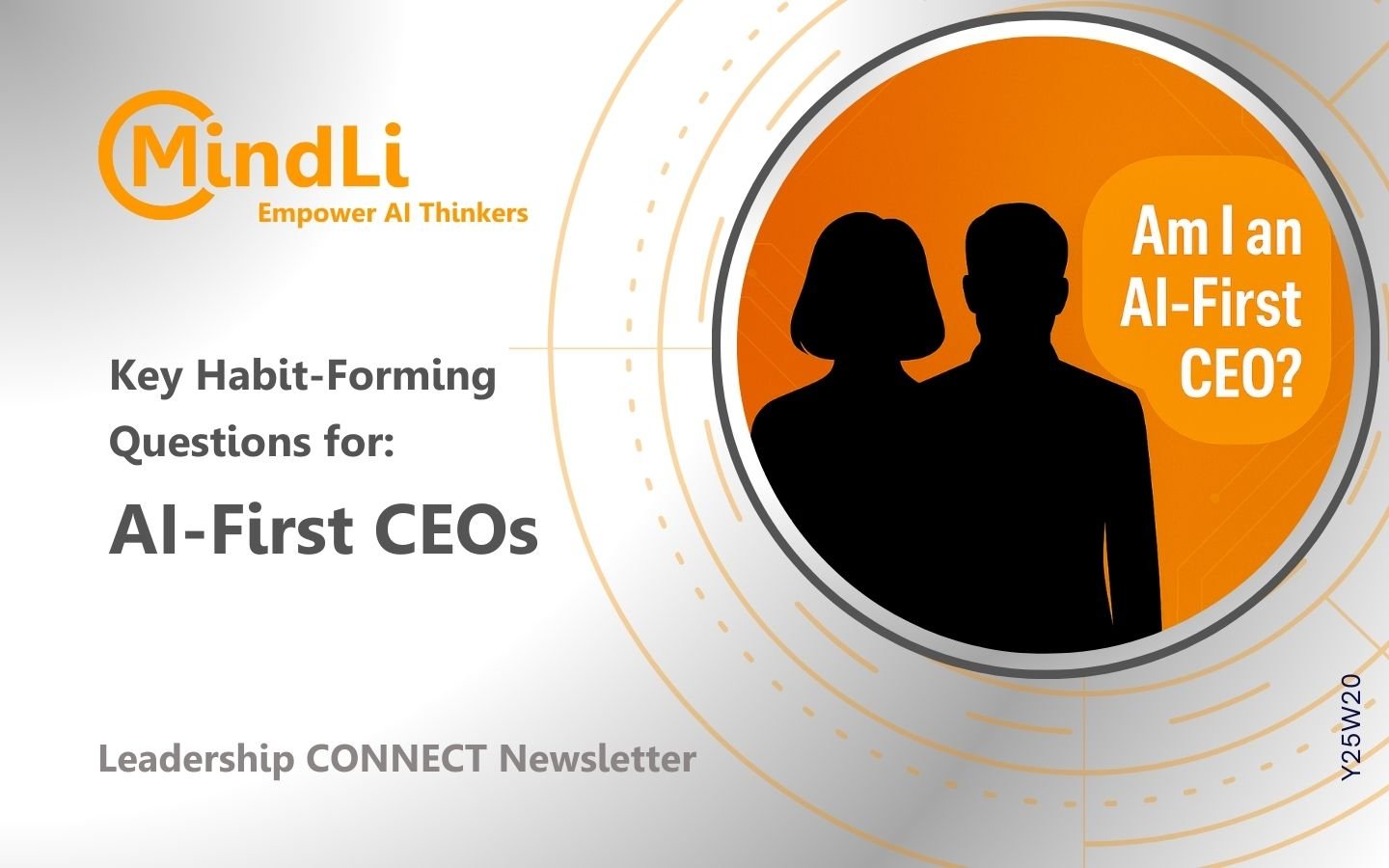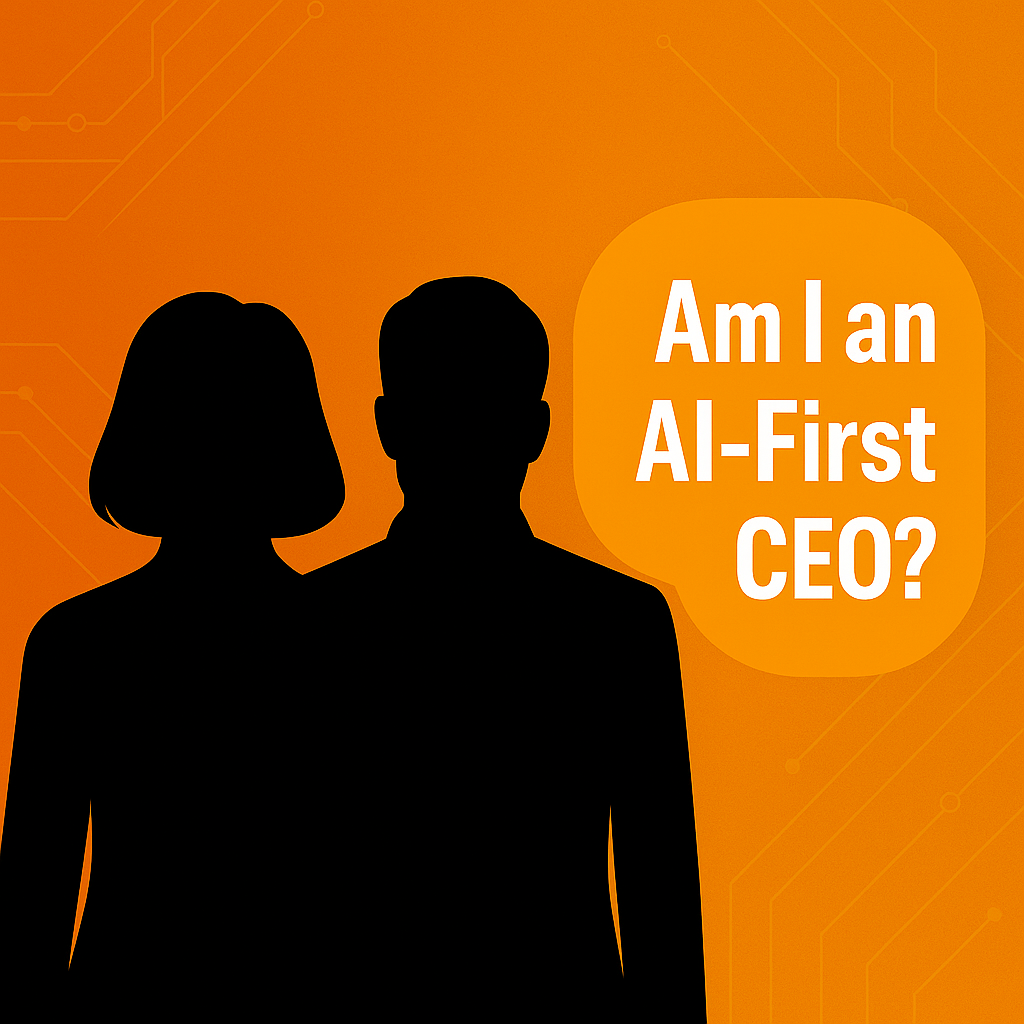Greetings AI Thinkers,
What does it mean to be an AI-First CEO? It stems from the “First Principles Approach” popularized by Peter Thiel.
In today’s post, we translate this theoretical approach into specific habit-forming questions that allow you to become “an AI-First CEO.”
Use it yourself, or forward it to your favorite CEO.
Happy Thinking,
Dr. Yesha Sivan and the MindLi Team
P.S. We are experimenting with a new format in which we have integrated additional information links into the main Spark rather than listing them as separate items.
P.S. Comments, ideas, feedback? Send me an e-mail.
Spark of the Week: AI First CEOs — Ask These Habit-Forming Questions (Source: Yesha on Human Thinking)
Three Approaches: Shopify, Johnson & Johnson & Meta
Recently (April 2025), we heard two conflicting views re AI in organizations:
- Jim Swanson, chief information officer at Johnson & Johnson, one of the largest healthcare companies, led a shift in generative AI strategy. “The company is making a shift to focus on only the highest-value GenAI use cases and shut down pilots that were redundant or underdelivering” (source: Wall Street Journal).
- Tobias Lütke, CEO of Shopify, emphasizes the transformative power of AI in our daily work. The message is clear: AI is no longer a luxury; it’s a baseline expectation. With AI as our thought partner, we can simplify the complexities of entrepreneurship and empower more individuals to embark on their business journeys than ever before. (Source: PDF of his memo in linkedin.)
In 2012, we had another revolution: Mobile came into our lives:
- Mark Zuckerberg, CEO of Meta (then Facebook), made a pivotal strategic shift by declaring the company would be “mobile-first.” Recognizing the explosive growth of smartphones, he redirected resources away from desktop development and pushed teams to prioritize mobile design, performance, and user experience. This transition included rebuilding the Facebook app natively and rethinking how the platform delivered ads and content. Zuckerberg’s mobile-first focus helped transform Facebook into a dominant player in the mobile era and laid the groundwork for its massive ad revenue growth in the following years. (Source: YouTube – Mark on being mobile.)
These are not conflicting views; all three are cases of the “First principles approach” modulated to the organization.
The First Principles Approach
The “first principles approach” is a problem-solving method rooted in physics and philosophy, dating back to Aristotle. It breaks complex problems down to their most fundamental truths and builds from there.
Instead of reasoning by analogy or convention, it challenges assumptions and reconstructs ideas from the ground up.
Entrepreneur and investor Peter Thiel popularized this thinking in the tech world, notably in his book Zero to One, where he emphasized its power in creating breakthrough innovations rather than incremental improvements. (See YouTube 3m video The First Principles Method Explained by Elon Musk.)
Sample Habit-Forming Questions for the CEO
In the context of AI, what does it mean to start from a “first principles approach”? Here are a few examples based on the “CEO Guide – Five Steps for AI Use” (we use the term habit-forming, as the more you ask them, the more you become an AI-First CEO):
- Generic Personal Tools: Encourage employees to use basic AI tools (e.g., ChatGPT, Microsoft Copilot) for personal productivity.
- Who is using AI?
- Who should use AI?
- How many new AI users should be hired?
- Which jobs can or should be replaced by someone who uses AI?
- Business Function Tools: To enhance workflows, implement AI solutions in specific departments like marketing or HR
- Some common functions (such as marketing, sales, and HR), which most organizations use, can greatly benefit from AI. Are we utilizing it?
- What processes can undergo complete change?
- What is no longer needed?
- Industry Tools: Adopt AI tools tailored to your industry, leveraging domain-specific models and datasets.
- Who are our competitors, and what are their AI activities?
- Who can be our competitors with AI?
- What narrow AI should we use to boost our capabilities?
- How can we leverage AI to expand into new markets?
- How will AI change the market?
- Embedded AI in Offerings: Integrate AI into your products or services to enhance value and customer experience.
- How can AI expand our products? There are some exciting opportunities here with the rise of MCP.
- Note: this applies to very few companies that have both a business case and the ability (see above, Shopify, and why J&J is focusing).
- Unique AI Capabilities: Develop proprietary AI innovations that differentiate your company from competitors
- This applies to even fewer companies. Developing your model is an expensive, complex, and long-term effort—it’s better to connect with some of the foundational models.
But, but, but — the blue ocean markets are here. So, depending on your maturity, risk appetite, and aspirations, please do dive in. (See more info on blue ocean.)
Lastly, my habit-forming recommendation is to print a similar poster and let you and the people you meet know that you are being “an AI-First CEO”.
P.S., As always, for daily updates on AI and its impact on humans, join our free private MindLi 🧠 AI LinkedIn Group
About MindLi CONNECT Newsletter
Aimed at AI Thinkers, the MindLi CONNECT newsletter is your source for news and inspiration.
Enjoy!
MindLi – The Links You Need
General:
- Website — MindLi.com — All the details you want and need.
- LinkedIn — MindLi 🌍 GLOBAL Group — Once a week or so, main formal updates. ⬅️ Start here for regular updates.
- WhatsApp — MindLi Updates — If you need it, the same global updates will be sent to your phone for easier consumption. This is similar to the above Global group — once a week or so.
- Contact us – We’re here to answer questions, receive comments, ideas, and feedback.
Focused:
- LinkedIn — MindLi 🧠 AI Group — More technical updates on AI, AGI, and Human thinking. ⬅️ Your AI ANTI-FOMO remedy — Almost Daily.
- LinkedIn — MindLi 👩⚕️HEALTHCARE Group — Specifically for our favorite domain — healthcare, digital healthcare, and AI for healthcare — Weekly.
- LinkedIn — MindLi 🛠️ FOW – Future of Work Group — thinking about current and future work? This is the place for you — Weekly.
- LinkedIn — MindLi 🕶️ JVWR – Virtual Worlds Group — About virtual worlds, 3D3C, JVWR (Journal of Virtual World Research), and the good old Metaverse — Monthly.
- LinkedIn — MindLi Ⓜ️ Tribe Group — Our internal group for beta testers of MindLi, by invite — when we have updates, call for advice, need for testing, etc (also ask about our special WhatsApp group).



